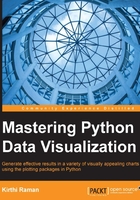
Chapter 2. Data Analysis and Visualization
Most visualization stories begin with some question that is oriented towards a topic where the data is being either explored or collected. The question contains the premise to the story and leads us to the point at which the data takes an expedition over the storyline. Such data expeditions that start with a question, for example, How many Ebola deaths were reported in the year 2014? are implemented by a group of people by collaborating with each other. The role of data communicators should be to create an information experience that transforms how their audiences think about their story.
The key parts of the story relate to the process of placing the visualization in a meaningful context. The context provides knowledge that answers questions such as the following:
- Is there sufficient data?
- Is there a time frame within which this data exists?
- Which associable events around the globe will influence this data?
To reiterate, it is important to understand the data, and identify the context of the question to which an answer is being attempted. Sometimes, one may start digging into the data before even finalizing the question, and in such a case, on gaining a refined understanding of the data, you may have an improved or clearer version of the question.
The process starts with the input data, assuming that one has ways to acquire, parse, and gather the required information from some source. There are some situations where it is better to visualize this collected information to eliminate noise, while in some other cases, one may filter and analyze the data before applying the visualization methods. In this chapter, we will learn the different ways of data exploration to further use them for visualization methods. We will also go through some interesting data stories and the related concepts in the following sequence:
- Acquiring, parsing, and filtering data to detect outliers and abnormalities, data mining and refining, visual representation, and interaction
- Creating interesting stories with data
- Perception, presentation methods, and best practice for visualization
- Interactive visualization—exploring event listeners and layouts